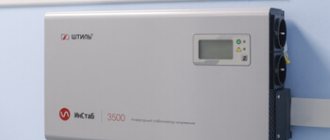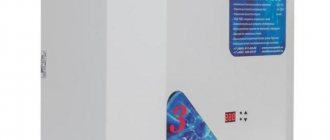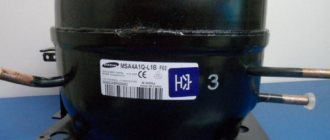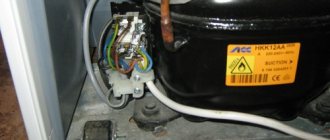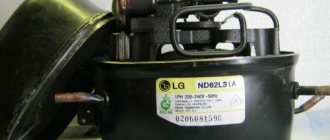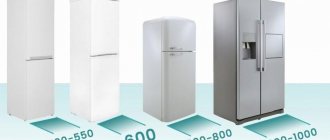If the voltage in our networks met the requirement of 220 V and +/- 10% in both directions, there would be no need to improve its characteristics. Home appliances, including refrigeration equipment, especially suffer from power surges. A voltage stabilizer for a refrigerator is needed to protect an expensive unit.
You will learn everything about choosing a device to protect a refrigeration machine from an unstable power supply from our article. We will talk about the types of devices and the rules for choosing them. Taking our advice into account, you can install surge protection yourself and extend its service life.
The importance of stabilizer in protecting a refrigerator
No matter what the latest technologies manufacturers use, no matter how many additional options the unit has, it is connected, like its simplest predecessor, to the same 220 V outlet. The input voltage in our networks is far from the best quality.
And the refrigerator is designed in such a way that its individual components are able to function normally only at a voltage with normal parameters. Voltage surges are especially dangerous for such an important element of the refrigerator as the compressor.
Its design includes a board responsible for regulating the cooling process, which is the most vulnerable point. As a result of a sudden increase in voltage, this expensive element may fail.
A voltage stabilizer is needed when operating a refrigerator connected to a network with characteristic voltage surges. For example, when connecting to old networks or a diesel generator
For the windings of an electric motor, both the long-term presence of low voltage and the long-term influence of a large starting current are dangerous due to the protracted process of activation at a low voltage. As a result of exposure to high temperatures on the windings, insulation melting is likely to occur.
Voltage correction is required not only for modern refrigeration equipment. Refrigerator models that were produced a long time ago are not equipped with protection against premature start-up.
Therefore, when the voltage is turned off and then abruptly turned on, the crank-slide pair of the compressor suffers as a result of water hammer in the space available above the piston. The stabilizer will turn off the power when the output voltage reaches its maximum, providing a time delay before the next start of the compressor.
Like other household appliances, food refrigerators are designed to operate continuously at normal voltage. When the voltage in the network has a significant difference from the nominal value, you cannot do without a stabilizer
Before deciding to purchase a stabilizer, you need to make sure the purchase is appropriate. To do this, you should study the parameters of the existing electrical network. It is recommended to measure the network voltage over several days during peak consumption.
It is advisable to use devices that record the current voltage. Foreign manufacturers designate this function as True PMS. If, based on the measurement results, it turns out that the controlled parameter did not exceed the limits of 205-235 V, a stabilizer will only be required for a new, expensive refrigerator model.
Its elements are especially sensitive to changes. The situation is considered critical when voltage deviations in the direction of increase exceed +10% or -15% in the direction of decrease.
According to the instructions of GOST number 32144-2013, indicated in paragraph 4.2.2, during voltage surges of up to 10%, a stabilizer is not required for the operation of the refrigerator. That is, when supplied by an alternating voltage network in the range of 198 - 242 V, the device may not be used for stabilization
In this case, connecting a stabilizer is a must. Most new models are equipped with built-in voltage stabilizers.
Their reliability is questionable, because... in practice, they do their job poorly when the network is heavily overloaded. In a critical situation, they themselves may become damaged and the unit will be left completely unprotected.
Types of stabilizers for refrigerators
Devices designed to stabilize voltage differ in both design, output power, and operating principle. Based on these characteristics, there are three types of refrigerator stabilizers: electromechanical, also known as servo drive, relay, triac or electronic.
The photo shows all three types of stabilizers: servo drive - the cheapest, relay, electronic - the most reliable, stable, but also expensive
Stabilizers are also divided by type of electrical network. They can be single- and three-phase. The first ones have compact dimensions, and since There is no cooling fan in their design; they make almost no noise during operation. The output voltage is monitored continuously, but the level of response to the input voltage is quite low.
For houses powered by a 380 V power supply, three-phase stabilizers have been developed that are designed for heavy loads, but when one of the phases fails, the protective mode does not work. Depending on the type of voltage in the network, devices are divided into those operating with low, high and intermittent voltage.
Electromechanical type devices
Servo-drive devices control the pantograph drive and monitor voltage parameters via an electronic board. High accuracy is their main advantage; the error is only 2-4%. The disadvantage is the speed caused by the inertia of 10-20 volts.
Electromechanical stabilizer - view from the inside. The slider, moving along the turns of the winding, changes the output voltage. A large number of nodes makes such devices short-lived
Such a stabilizer works well under conditions of either slowly changing voltage, or consistently low, or high voltage. If there are strong abrupt changes, the device will quickly become unusable. Such conditions are most often observed in dachas and country cottages, so this option is not suitable here.
Relay type stabilizer
A simple relay type stabilizer control system can withstand significant differences. On its electronic unit, as well as on the controller, there are power relays, which are responsible for switching the transformer windings. The transition occurs extremely quickly - in just 0.5 seconds.
The photo shows a relay type stabilizer. This equipment is the most common in everyday life. Often consumers are attracted by its relatively low cost
The weak link is the microcontroller. It can burn out if it cannot withstand the excessive mobility of the input voltage.
The work of switching transformer stages is accompanied by clicking noises, which does not add comfort to the home. Such models are intended for use in networks where rapid voltage reboot occurs constantly.
System models of devices
There is no such element as a relay in the electronic stabilizer; the control is managed by semistors, which quickly respond to the slightest changes in the network. The absence of mechanical contacts makes it possible to carry out multiple switching noiselessly during power outages.
Thyristor stabilizer SKAT ST-12345. It covers a wide range of input voltages, is characterized by high power and stabilization speed, and complies with all domestic and international standards
They can withstand voltage overloads of up to 20% for 12 hours, and up to 100% for one minute. Manufacturers of system stabilizers place high demands on the quality of parts and assembly accuracy, so both the durability and cost of the devices are appropriate.
Types of stabilizing devices
Equipment for stabilizing network voltage differs in operating principle, power and design features. Based on these characteristics, three types of devices in this direction can be distinguished:
- servo-driven;
- relay;
- electronic.
Depending on the deviations in the network, there are devices that operate with low, high and surge voltage. Single-phase stabilizers used in domestic conditions are compact, operate in constant mode and are not equipped with forced ventilation.
Attention! For rooms powered from a three-phase source (380 V), stabilizers of the appropriate type are used. They are designed for heavy loads, but most houses and apartments do not have such a connection point, and refrigeration equipment for home use is designed for 1 phase.
Servo stabilizers
The devices of the electromechanical device control the output voltage parameters through an electronic board. The main advantage of the device is the stability of the output characteristics and accuracy up to 96-98%. One drawback is that such equipment responds slowly to changes in the network. The servo stabilizer inside consists of the following parts:
- Toroidal transformer (round coil) with variable output point.
- The drive responsible for moving the contact.
- A board that controls indicators and voltage changes.
This type of stabilizer, due to its slow response, is more suitable in cases of stably increased or stably decreased voltage. If measurements indicate abrupt changes in indicators, then a refrigerator with a slow response can quickly become unusable. The servo-drive stabilizer is more suitable for holiday villages and country houses far from enterprises.
Relay type stabilizers
The relay voltage stabilization control system can withstand large fluctuations. Such equipment is lower in cost compared to electronic and servo-driven ones. The switching unit for transformer windings operates on the basis of a microcontroller and power relays to stabilize the voltage. This structure ensures a quick response to changes in the network - the device responds in 0.5 seconds.
The weak side of the relay stabilizer is the microcontroller, which can burn out if the input voltage constantly changes. Also, the presence of constant clicks is noted as a disadvantage - the sound is loud and does not contribute to comfort in the room.
Electronic stabilizers
Electronic type stabilizing equipment does not provide a relay - the device control is based on triacs. These semiconductors are responsible for fast switching in AC networks and provide fast and silent switching between transformer contacts. The increased stability of the stabilizers of such a device gives a wide voltage range and stands out among analogues with high power.
In the presence of network overloads of up to 20%, such a stabilizer is capable of providing normal voltage for up to 12 hours, and at 100% for 1 minute. Due to the characteristics of the semiconductor device and high requirements for the quality of the elements, electronic type stabilizers are durable, but have a high price.
Inverter
Inverter stabilizers are a relative novelty - such devices are based only on electronic parts - transistors and microcircuits. With this design, the electric current undergoes a double transformation. The operating principle of an inverter stabilizer can be described as follows:
- Alternating current enters the device through the input rectifier and is converted into direct current, with a high power factor.
- The energy is accumulated in capacitors in sufficient volume and sent through a frequency filter to the output inverter.
- Direct current, when passing through the secondary inverter, is converted into alternating current with indicators of 50 hertz and 220 V.
Such devices, due to two processes, are also called double conversion stabilizers. The obtained characteristics at the terminals fully comply with the standards. The main advantage of inverter devices is their small size and complete absence of noise. But the price of stabilizers based on the principle of double electronic conversion is high due to the complexity of producing components.
Criteria for choosing a device for stabilization
The main criterion for selection is power. This is followed by indicators such as voltage stabilization stages, response speed, accuracy and range. Auxiliary parameters - noise level, input voltage, presence of additional options.
When choosing a device for voltage stabilization, in addition to cost and sound level, you should pay attention to the speed of correction of network parameters and reliability (+)
Stabilizer power calculation
This parameter is very important for the stabilizer. Here we mean the total power at the input under voltage conditions of 220 V. The active power characteristic of the refrigerator can be found from its passport, but the total power is included in the calculations.
Since the refrigerator is an induction component, we are dealing with a reactive load in the circuit and an additional indicator - cos φ. This parameter can be found in the equipment passport.
The total power is equal to the quotient of the active power in watts divided by cos φ, which for a refrigerator is 0.9. If this value cannot be found, then the power should be divided by 0.7.
When starting up, the refrigerator has a large starting current, sometimes up to 5 times the rated current. For this reason, there is a threefold increase in total power. So, for a refrigeration unit with a power of 600 W, the maximum power will be: (600 x 3) : 0.9 = 2000 W. The active power is added to the maximum power and the device power is obtained.
Since the stabilizer is a low-inertia device with a quick response to any changes in the load or input network, it requires some power reserve. Otherwise, starting the refrigerator motor-compressor will trigger the protective function due to overload.
The diagram clearly shows how the starting current values exceed the operating parameters. Even though this is a short-term load, it cannot be neglected (+)
If the starting and rated power is known, you can approach the calculation differently. For example, a Wirlpool ARC4020 refrigerator with a rated power of 200 W and a starting power of 1000 W.
You need to find the difference between these values: 1000 – 200 = 800 W. The maximum power will be: 200 + 800 = 1000 W. Taking into account the 20% margin, the required stabilizer power is found: 1000 x 1.2 = 1200 W = 1.2 kW.
If the stabilizer is planned to be installed not only for the refrigerator, but for all electrical appliances in general, its power is calculated using the parameters of the machine. To do this, the voltage is multiplied by the current value, which is found on the marking of the machine. When the voltage is 220 V and the current is 16 A, then the stabilizer should have a voltage of 3520 W.
The power of the stabilizer must ensure adjustment of the starting currents of the refrigerator compressor or a group of devices started simultaneously
Selection by response speed
An unstable network requires a device with a high response speed. Therefore, an electromechanical stabilizer of the old type, operating according to the LATR principle, is inappropriate in such conditions, because has a low stabilization speed.
When a surge appears in the network, the time period for setting the value can take up to three seconds. Under conditions of a very high voltage surge, the refrigerator will have time to fail.
The response speed sufficient to protect the refrigerator from power surges is considered to be 10 - 20 ms. In 20 milliseconds, just one period of the voltage supplied by the household network fits
Even the high accuracy of the device cannot compensate for this drawback. If you make a choice based on this parameter between a relay and a seven-storage stabilizer, then their response to voltage drops is almost the same. At the same time, the device of the first type will cost less. The advantage of the second is absolute noiselessness.
Stabilizer accuracy and range
The marking of these devices necessarily includes such a parameter as accuracy. It is designated by the symbols “U”, which means narrow and “Pt” - increased accuracy. There are also markings in the form of the symbols “Ptt”, “Pttt”.
For a refrigerator, the first two are usually chosen. The second two are necessary for equipment used in medicine in case of large range fluctuations.
A wide range of operating voltages is a good characteristic for a stabilizer. A typical plug is 120 - 300 or 100 -260 V. When choosing a suitable device, you can use this graph (+)
Among the three types of stabilizers, the dynamic type has the greatest accuracy. In the other two, voltage changes occur in steps. It is really impossible to get exactly 220 volts; at the input it will be either slightly positive or slightly negative relative to the nominal value. But these values will not exceed the tolerance laid down in GOST clause 4.2.2 of GOST 32144-2013.
Input voltage and other parameters
In household networks, deviations from standard 220 V are allowed, but not more than 10%. If you are sure that the tolerance will not be exceeded, then you do not need to buy a stabilizer, but this happens very rarely. Much more often, the voltage range varies from 140 to 270 V, or even more.
For this reason, when choosing a device, you need to look at the documentation. Here you will find the permissible input voltage range, and it is different for each model. Other parameters include noise level and input voltage geometry.
For the most popular refrigerator models, you can select a stabilizer using this table. Here the power of the device is tied to the power of the compressor (+)
If a smooth sinusoid is needed for the device to operate, then this point should be key when choosing a device. A plus for the stabilizer is the presence of such an option as bypass mode. This function opens the way for input voltage to flow directly.
If the voltage in the network complies with the regulations, it is supplied to the refrigerator directly. In case of deviations from the nominal value, a stabilizer is switched on in the circuit.
Features of installation and connection of the stabilizer
In the stabilizer data sheet, manufacturers indicate the temperature conditions that are optimal for its operation. The lowest temperature threshold for single-phase household appliances is +5⁰, for three-phase -5⁰С. Upper limit +45⁰. The heat generated by the stabilizer during operation is removed using ventilation - natural or forced.
In order for this system to function normally, the device body with holes for ventilation is removed from the enclosing structures at a distance of about 0.5 m. If the stabilizer is not very heavy, it can be placed on a shelf or on a table; hanging models are also available.
A device of sufficient weight is placed on the floor, but in such a way that there is no soft covering underneath, which worsens the conditions for the normal operation of ventilation. It is not recommended to place the stabilizer near the bedroom, because even at a low noise level, it will still interfere.
The diagram shows a stabilizer in a 220 V network when it is connected at the entrance to the building. It is located immediately behind the meter and in front of the load.
To supply the refrigerator with normal quality power supply, single-phase models of stabilizers are used. As a rule, their power does not exceed 3 kW.
Some devices of this type have one or two sockets and a cord with a plug on the back of the case. To connect an electrical appliance to the network, you do not need to be a specialist. The plug is simply inserted into the socket, and then the refrigerator is turned on through the stabilizer.
It happens that the case is equipped only with terminals, then the cord and plug are purchased additionally. The ends of the first are screwed to the terminals.
To fix the position of the electronic keys or brushes at which the supply of stabilized current begins, the stabilizer is first turned on for a moment. After the voltmeter readings stop at 220 V, the device is immediately turned off.
All that remains is to connect a wire with a socket to the output, and a refrigerator into it. If 380 V is supplied to the house, one three-phase stabilizer is installed, then its influence will extend not only to the refrigerator, but also to other electrical appliances. Another option is used - three single-phase stabilizers with a star connection.
Model overview
Let's consider 5 models of stabilizers of various brands and characteristics that have proven themselves to be the best :
- LG-2500 is one of the expensive but irreplaceable models of stabilizers for home use. A power of 2.5 kW allows you to power not only the refrigerator, but also other appliances (washing machine, iron, boiler). Its price varies from 13,000 to 18,000 rubles, depending on the configuration.
Atlant, model Energy SNVT-1500 is a domestic unit that is ideal for use in a refrigerator. Designed for input voltage from 100 to 280 V. It has good technical characteristics, as well as a warranty period of 2 years. The cost is more affordable, only 5000-7000 rubles.
Upower-ACH-1500 is the most economical model, which has the same characteristics as the above analogues, but is made in a budget version. Its cost is 3000-4000 rubles.
Woltron PCH-1500 - used exclusively for single-phase networks. Stabilizes input power from 100 V to 280 V. Price – 4000 rubles.- Ampere 1500 - designed for a three-phase network, has additional functions, as well as the ability to independently set the necessary parameters. The average price in retail trade is 10,000-12,000 rubles.
Another stabilizer in the video
These models
have good reviews and are also in demand among buyers.
Thus, the stabilizer is important and needed not only for the refrigerator, but also for other household appliances. His role is difficult to overestimate. The presence of a stabilizer is already a guarantee that the refrigerator will be able to operate smoothly and will also avoid breakdowns and costly repairs. Selecting it is not difficult, knowing parameters such as total power and network phase. Many models differing in their parameters allow you to select a unit that will satisfy all the technical characteristics of the network.
Safe operation of the device
We should not forget that the device is not protected against moisture getting inside its housing. Therefore, you cannot place any dishes with liquid on it, or wipe it with a damp cloth. Detergents are also contraindicated for care.
A stabilizer will help eliminate many problems in your home network, but during its operation you must follow electrical safety precautions
Electrical safety rules strictly prohibit contact of the housing with metal surfaces. Also, the ventilation grilles must not be allowed to close, otherwise the device will overheat and subsequently fail.
Overload is also dangerous for the stabilizer. It can arise when, in addition to the refrigerator, some other household appliances are connected to it, which were not taken into account when performing the power calculation.
If such a connection is necessary, you must first check that the total load does not exceed the permissible limit. In any case, to protect several devices, it is better to purchase a voltage stabilizer for your home with characteristics designed for their operation.
Which voltage stabilizer is best for a refrigerator?
You can understand whether your refrigerator needs a stabilizer by listening to the operation of the device. If the compressor operates without jerking and smoothly starts and ends the cycle, the voltage in the network is normal. Modern models have protection against quick start inside, so seconds of interruptions in supply may not affect the compressor. So a stabilizer is not always needed. But electronically controlled equipment with displays and controlled from a smartphone are better protected, just in case.
Which voltage stabilizer is best to choose for refrigerators, from the point of view of practitioners and specialists? In terms of price, Chinese stabilizers are considered the most affordable, but their quality is such that manufacturers do not advertise their country of origin. It is better not to buy stabilizers under 2000 rubles; they are produced in China only for Russia. What damage a cheap refrigerator stabilizer can cause, and whether it is needed, is up to you to decide.
Affordable Russian and Ukrainian models have gained popularity. Which voltage stabilizer to choose for a refrigerator depends on the technical parameters. The best stabilizers are:
- "Shtil" Tula, R1200, R 2000 relay;
- high-precision triac R1200 SPT, R2000SPT;
- stabilizers based on thyristors 1500T, 2000T, Pskov;
- SSK devices.
The technology is developing, we called the products the best based on reviews, but there are other worthy models. We are waiting for your conclusions about the purchased stabilizers.
Manufacturers and models of stabilizers
The first place in the rating of household stabilizers is occupied by the domestically produced relay device RUCELF SRFII-6000-L. Its design takes into account all the features of our electrical networks. It operates stably in the voltage range from 110 to 270 V.
The power of the RUCELF SRFII-6000-L stabilizer is 5 kW, efficiency is 98%. The voltage equalization process is very fast, but the cooling system is noticeably noisy
Among the high-quality devices offered by the International Trademark RUCELF, there are other good models. In particular, the compact vertical relay-type stabilizer RUCELF SDWII-6000-F with a power of about 6 kW is popular.
It is silent in operation, is fast, produces little heat, operates in the range of 145-265 V. Its price is quite high, but it has additional options: delayed start, bypass, self-diagnosis system.
As a budget option, you can consider the Bastion Teplocom ST-555 model. It is designed for a wide range of voltages, but the accuracy rate is quite low - 8%. The device weighs only 2 kg.
Bastion Teplocom ST-555 is the best option for small facilities with autonomous networks. It is compact, wall-mounted, and has a power of 7 kW.
If noise doesn’t bother you, then the Luxeon WDR-10000 model is quite acceptable for everyday use. Despite the Chinese assembly, the device works stably and has a stylish design. The Sven AVR PRO LCD 10000 wall-mounted device is suitable for both the office and home.
The Sven AVR PRO LCD 10000 device is designed to adjust the voltage for powering a wide range of household appliances. Equipped with a small LED indicator that displays the characteristics of the incoming/outgoing current, the status of the device, there is a pause function and protection against short circuit and overheating
It has small dimensions, but is heavy (18.5 kg), since high-quality components were used for assembly. The unit is noisy, but the voltage levels out smoothly. Since it has high power, it cannot be connected to a regular outlet. When connecting, use special terminals. There is no bypass in the design.
